The Bund, Shanghai
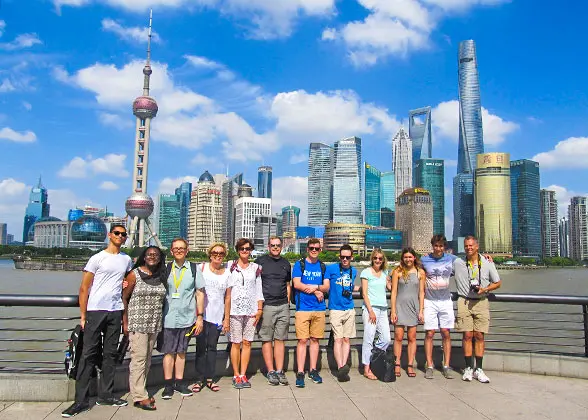 |
| The Bund, Shanghai |
the bund in shanghai - Our Tour Group at the Bund, Shanghai
3-Day Shanghai Tour from $179
5-Day Shanghai - Suzhou - Zhouzhuang $509
8 Days Beijing - Xian - Shanghai
Small Group from $839
Private from $1269
More Shanghai Tours
The Bund, also called Zhongshan Dong Yi Lu (East Zhongshan 1st Road), is a famous waterfront and regarded as the symbol of Shanghai for hundreds of years. It is on the west bank of Huangpu River from the Waibaidu Bridge to Nanpu Bridge and winds 1500 meters (0.93 mile) in length. The most famous and attractive sight which is at the west side of the Bund are the 26 various buildings of different architectural styles including Gothic, Baroque, Romanesque, Classicism and the Renaissance. The 1,700-meters (1,859 yards) long flood-control wall, known as 'the lovers' wall', located on the side of Huangpu River from Huangpu Park to Xinkai River and once was the most romantic corner in Shanghai in the last century. After renovation, the monotone concrete buildings that lovers leaned against in the past have been improved into hollowed-out railings full of romantic atmosphere. Standing by the railings, visitors can have a 'snap-shot' view of the scenery of Pudong Area and Huangpu River.
History
Before the 1840s, the Bund was a muddy narrow lane with tall reeds. It initially became a British settlement. After Shanghai was established as the trading port in 1846, a street was paved there and the riversides were reinforced. Then, rows of commercial buildings were constructed. As the UK Concession, a building boom at the end of 19th century and beginning of 20th century led to the Bund becoming a major financial hub of East Asia. It was the centre of the city's politics, economy and culture more than a hundred years ago, consulates of most countries and many banks, businesses and newspaper offices were settled there, and that's why we have these art-like buildings.
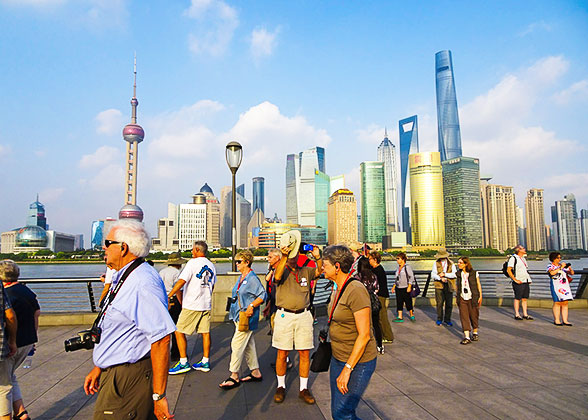
Pudong seen from the Bund
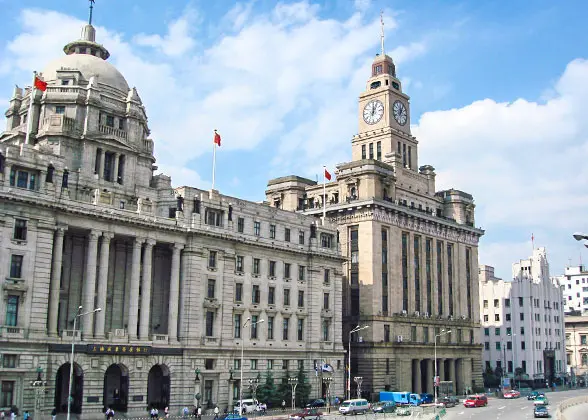
Western-style architectures along the Bund
In the late 1970s and early 1980s, with the thawing of economic policy in the People's Republic of China, buildings on the Bund were gradually returned to their former uses. Government institutions were moved out in favor of financial institutions, while hotels resumed trading as such.
In the 1990s the Shanghai government attempted to promote an extended concept of the Bund to boost tourism and land values in nearby areas, as well as to reconcile the promotion of 'colonial relics' with Socialist ideology. From 2008, a major reconfiguration of traffic flow along the Bund was carried out. After a 33-month upgrade, the Bund was reopened to visitors on March 28, 2010. The veil on the new Bund was finally lifted.
After the reconstruction, most transit vehicles which originally got through the ground level roads began to make their way through the new underground tunnel. The original eleven driveways on the Bund ground were compressed into four two-way lanes. Thus more space was left for expending the four major squares: Huangpu Park, Chen Yi Square, the Bund Financial Square, and the Observatory Plaza. After being reconstructed, the new Bund waterfront is neat and atmospheric. The public activity space is expansive embracing more visitors.
Map of the Bund

Buildings Group
Buildings of No.1 - No.9
Buildings of No.12 - No.18
Buildings of No.19 - No.29
The Bund has been called a 'museum of international architecture' and indeed it was and still is. But it was also much more. Here were located the banks, hotels, exclusive clubs, press organizations and headquarters of international concerns. The twenty-six major structures, of various heights along approximately 1.5 kilometers of Zhongshan Lu and the Huangpu River, have changed little externally since the 1930s. All were constructed in western-inspired styles. After the establishment of the People's Republic of China in 1949 the old tenants were gone. They had already been impacted by the wartime crises. Many of the structures were subdivided into government offices, department stores or storage areas. Furnishings were sold off or destroyed, and architectural features covered.
City Sculptures
Near the Nanjing Road intersection stands what is currently the only bronze statue along the Bund, a statue of Chen Yi who was the first Communist mayor of Shanghai. At the northern end, along the riverfront, is Huangpu Park, in which is situated the Monument to the People's Heroes - a tall, abstract concrete tower which is a memorial for those died during the revolutionary struggle for Shanghai dating back to the Opium Wars. As the victor of the war, the British nationals in the Bund put up a 'cross' to mark their 'aggression' which is the Red Rock Monument. On the south side of the Bund Garden Bridge stands an Ever Victorious Army Monument, which was funded by Li Hongzhang to commemorate the officers and soldiers of the Victorious Army who died in the battles against the Taiping Army from 1862 to 1864. Located in front of Shanghai Custom House at Jiujiang Road, the statue Hart was regarded as the most famous statue in Shanghai history. Hurt, British Northern Irishman, had served as Secretary General of Chinese Customs up to 48 years. Another famous sculpture is the World War Monument which was the largest one in the city at that time. It was made to commemorate the soldiers who died in the World War I coming from Shanghai.
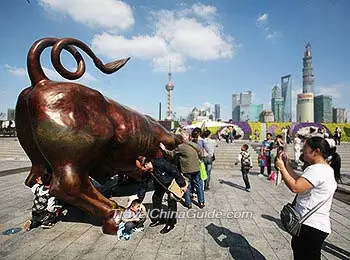
Sculpture on the Bund
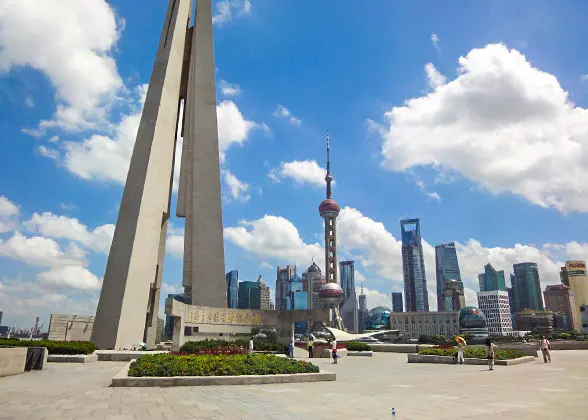
Monument to the People's Heroes
Night View
It is worth a visit to see the florid night view of the Bund. Under the tenet of keeping harmony and unity, the use of period lamp-posts is in keeping with the aesthetic feeling of the building structures. It fully exhibits the magnificence of the various buildings of different architectural styles and make up of the best night scene of Shanghai together with the colorful lights floating in the river and the flashing lights on the far side of the river. The night piece of the Bund was named in 'Shanghai top ten night light views' in 2009.
Further reading: Huangpu River Cruise
Tip: There is an eco-friendly mobile charging system with solar photovoltaic power generation at the photography point of the Bund scenic area. It can provide the power of the computer for photographers to print the photos, as well as mobile phone emergency charging service for visitors.
FAQ on the Bund
FAQ about its location, opening hours, sightseeing duration and nearby scenic spots.
The Bund
Tourists on the Bund
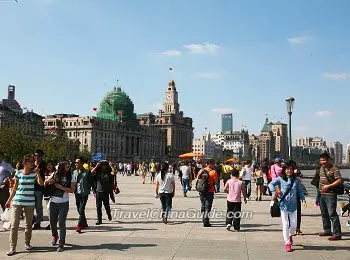
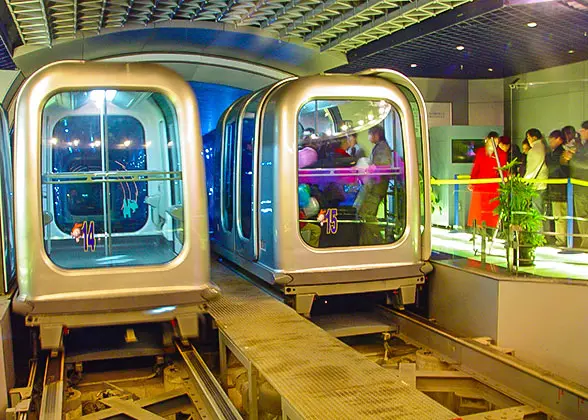
Sightseeing Maglev in the Sightseeing Tunnel
Transportation Shanghai Bus / Subway Search
By Bus:
Take bus 33, 37, 55, 65, 147, 305, 307, 317, 330, 921 and get off at East Zhongshan 1st Road / East Nanjing Road
Take bus 123, 135, 145, 576, 934 and get off at East Zhongshan 1st Road / Hankou Road
Take bus 576 or 868 and get off at East Zhongshan 1st Road / Guangdong Road
Take bus 220 or 939 and get off at Middle Sichuan Road / Hong Kong Road
Take bus 42, 71, 311, 316, 320 and get off at East Yan’an Road / East Zhongshan 1st Road
Take bus 20 and get off at Jiujiang Road / East Zhongshan 1st Road
Take Tunnel Line 9, bus 26 or 926 and get off at East Jinling Road / East Zhongshan 2nd Road
Take City Sightseeing Bus to get there.
By Subway:
Take Line 2 or Line 10 to East Nanjing Road Station. Then walk about 10 minutes toward the Huangpu River.
By Ferry:
There are scheduled ferryboats between East Jinling Road Ferry Dock / The Bund in Puxi and Dongchang Road Ferry Dock in Pudong. The ferry ticket costs CNY 2. Walk toward Huangpu River from East Nanjing Road and turn right to walk down along the Bund, East Jinling Road Ferry Dock can be seen soon. Dongchang Road Ferry Dock is about 10-15 minutes' walk south of the Oriental Pearl TV Tower.
The Sightseeing Tunnel:
There is a total 646.7 meters sightseeing tunnel from the Bund in Puxi to the Oriental Pearl TV Tower, Lujiazui area in Pudong. It only takes 3-5 minutes by the speed train through the tunnel with colorful radiating lights around. It is open from 8:00 to 22:30, perhaps till 22:00 in winter . CNY 45 for single trip is not cheap for this 3-5 minutes journey, but CNY 55 for round trip sounds more resonable. This is a short but unique experience. The Puxi Entrance/Exit is in the north side of Chenyi Square, which can be easily found at the Bund from East Nanjing Road or East Beijing Road. Pudong Entrance/Exit is next to the south of Shanghai International Convention Center, near to the south entrance of the Oriental Pearl TV Tower.
With the information we provide about the bund in shanghai
, We hope you can be helped and hopefully set a precedent with you . Or also you can see our other references are also others which are not less good about 6 Ways to Iron Your Clothes Without an Iron
, So and we thank you for visiting.
open tutorial sew : https://www.travelchinaguide.com/attraction/shanghai/bund.htm




0 komentar:
Post a Comment